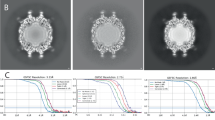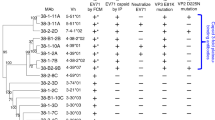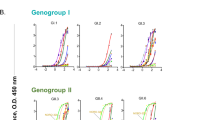Abstract
A KINETIC analysis of the neutralization of influenza virus by rabbit antibody indicated that the combination proceeds in two stages1. The first stage is the formation of a freely dissociable union between the virus and antibody. This is followed by a second stage which leads to the stabilization of the complex between the virus and antibody. The reaction kinetics also indicated that a single antibody molecule could form a stable combination with the virus particle. In an attempt to elucidate the nature of the stage of stabilization, the interaction between influenza virus and the univalent antibody fragments, produced by papain digestion2, was investigated3. This investigation demonstrated that although the monovalent fragments could combine reversibly with the virus and neutralize its infectivity, they were unable to form a stable combination with the virus. It could be concluded that the stabilization of the combination between the virus and antibody depended on the divalent nature of the antibody molecule. On the basis of the foregoing conclusions and observations the following hypothesis emerged. The first stage in neutralization would be the attachment of the antibody molecule to the surface of the virus through one combining site and the second and stabilizing stage would be brought about by the attachment of the second combining site on the divalent antibody molecule to the same virus particle.
This is a preview of subscription content, access via your institution
Access options
Subscribe to this journal
Receive 51 print issues and online access
$199.00 per year
only $3.90 per issue
Buy this article
- Purchase on Springer Link
- Instant access to full article PDF
Prices may be subject to local taxes which are calculated during checkout
Similar content being viewed by others
References
Lafferty, K. J., thesis, Australian National University (1961).
Porter, R. R., Biochem. J., 73, 119 (1959).
Lafferty, K. J., Virology (in the press).
Anderson, T. F., and Stanley, W. M., J. Biol. Chem., 139, 339 (1941).
Kleczkowski, A., Immunol., 4, 130 (1961).
Fazekas de St. Groth, S., and Graham, D. M., Brit. J. Exp. Path., 36, 205 (1955).
Fazekas de St. Groth, S., Withell, J., and Lafferty, K. J., J. Hyg. (Camb.), 56, 415 (1958).
Brenner, S., and Horne, R. W., Biochim. Biophys. Acta, 34, 103 (1959).
Haurowitz, F., and Schwerin, P., J. Immunol., 47, 111 (1943).
Nisonoff, A., Winkler, M. H., and Pressman, D., J. Immunol., 82, 201 (1959).
Author information
Authors and Affiliations
Rights and permissions
About this article
Cite this article
LAFFERTY, K., OERTELIS, S. Attachment of Antibody to Influenza Virus. Nature 192, 764–765 (1961). https://doi.org/10.1038/192764a0
Issue Date:
DOI: https://doi.org/10.1038/192764a0
This article is cited by
-
Location of proteins S5, S13 and S14 on the surface of the 30S ribosomal subunit from Escherichia coli as determined by immune electron microscopy
Molecular and General Genetics MGG (1974)
-
The fine structure of influenza A, B and C viruses
Archiv f�r die gesamte Virusforschung (1963)
-
Antigen-antibody reactions of influenza virus as seen in the electron microscope
Archiv f�r die gesamte Virusforschung (1963)
Comments
By submitting a comment you agree to abide by our Terms and Community Guidelines. If you find something abusive or that does not comply with our terms or guidelines please flag it as inappropriate.



